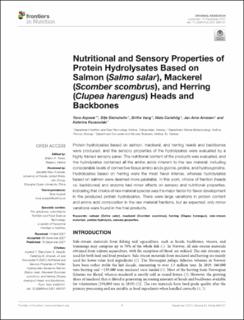Nutritional and Sensory Properties of Protein Hydrolysates Based on Salmon (Salmo salar), Mackerel (Scomber scombrus), and Herring (Clupea harengus) Heads and Backbones
| dc.contributor.author | Aspevik, Tone | |
| dc.contributor.author | Steinsholm, Silje | |
| dc.contributor.author | Vang, Birthe | |
| dc.contributor.author | Carlehög, Mats | |
| dc.contributor.author | Arnesen, Jan-Arne | |
| dc.contributor.author | Kousoulaki, Katerina | |
| dc.date.accessioned | 2021-12-14T09:28:47Z | |
| dc.date.available | 2021-12-14T09:28:47Z | |
| dc.date.created | 2021-12-13T15:53:39Z | |
| dc.date.issued | 2021 | |
| dc.identifier.issn | 2296-861X | |
| dc.identifier.uri | https://hdl.handle.net/11250/2834121 | |
| dc.description.abstract | Protein hydrolysates based on salmon, mackerel, and herring heads and backbones were produced, and the sensory properties of the hydrolysates were evaluated by a highly trained sensory panel. The nutritional content of the products was evaluated, and the hydrolysates contained all the amino acids inherent to the raw material, including considerable levels of connective tissue amino acids glycine, proline, and hydroxyproline. Hydrolysates based on herring were the most flavor intense, whereas hydrolysates based on salmon were deemed more palatable. In this work, choice of fraction (heads vs. backbones) and enzyme had minor effects on sensory and nutritional properties, indicating that choice of raw material species was the major factor for flavor development in the produced protein hydrolysates. There were large variations in protein content and amino acid composition in the raw material fractions, but as expected, only minor variations were found in the final products. | |
| dc.language.iso | eng | |
| dc.title | Nutritional and Sensory Properties of Protein Hydrolysates Based on Salmon (Salmo salar), Mackerel (Scomber scombrus), and Herring (Clupea harengus) Heads and Backbones | |
| dc.type | Peer reviewed | |
| dc.type | Journal article | |
| dc.description.version | publishedVersion | |
| dc.source.volume | 8 | |
| dc.source.journal | Frontiers in Nutrition | |
| dc.identifier.doi | 10.3389/fnut.2021.695151 | |
| dc.identifier.cristin | 1967889 | |
| dc.relation.project | Nofima AS: 12320 | |
| dc.relation.project | EU/790956 | |
| cristin.ispublished | true | |
| cristin.fulltext | original | |
| cristin.qualitycode | 1 |
Tilhørende fil(er)
Denne innførselen finnes i følgende samling(er)
-
Artikler / Articles [1419]
-
Publikasjoner fra CRIStin [2481]
